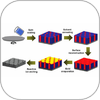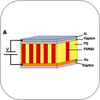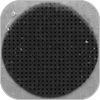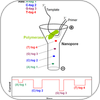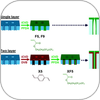A perpendicular orientation of cylindrical microdomains in diblock copolymer thin films is achieved by control over polymer-surface interactions. The block which forms cylindrical microdomains is removed by UV exposure and a chemical rinse to yield a nanoporous polymer film. The porous film can be used as a template for electrodeposition of metal nanodots or as a mask for reactive ion etching.
Nanopores
An evaporation-induced flow in solvent cast block copolymer films can produce arrays of nanoscopic cylinders oriented normal to the surface and solvent annealing could markedly enhance the ordering of block copolymer microdomains in thin films. Without removing minor components, solvent-induced surface reconstruction can produce nanoporous structure in thin films. The porous film can be used as a template for deposition of quantum dots or as a mask for pattern transfer to the underneath substrates.
An applied electric field aligns a cylindrical-phase diblock copolymer perpendicular to a substrate. One polymer block is removed by UV exposure and a chemical rinse to yield a nanoporous polymer film. The porous film can be used as a template for electrodeposition of metal nanowires or as a mask for reactive ion etching.
Research areas:
- Energy Generation from Thermopower Waves
- Exciton Engineering
- Graphene Enhanced Materials
- Nanosensor Platforms for the Study of Cellular Signaling
- Single Carbon Nanotube Nanopores
SiNode is a materials venture based out of Northwestern University that is commercializing a novel silicon based anode technology developed by Professor Harold Kung. The company is currently seeking partnership opportunities with major chemicals manufacturers.
Izon has developed accurate instrumentation for nanoscale particle analysis. The instrument systems, the qNano and qViro, are now in use in a wide range of research institutes and universities around the world.


